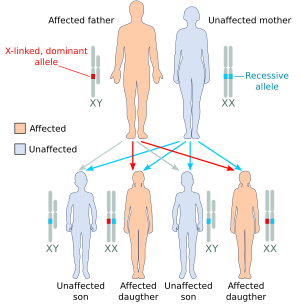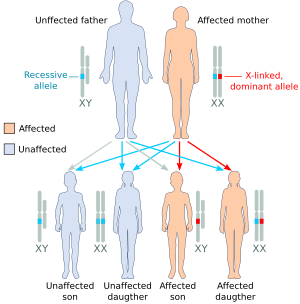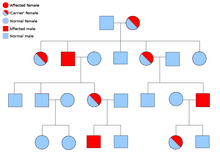
Sex linked describes the sex-specific reading patterns of inheritance and presentation when a gene mutation (allele) is present on a sex chromosome (allosome) rather than a non-sex chromosome (autosome). In humans, these are termed X-linked recessive, X-linked dominant and Y-linked. The inheritance and presentation of all three differ depending on the sex of both the parent and the child. This makes them characteristically different from autosomal dominance and recessiveness.
There are many more X-linked conditions than Y-linked conditions, since humans have several times as many genes on the X chromosome than the Y chromosome. Only females are able to be carriers for X-linked conditions; males will always be affected by any X-linked condition, since they have no second X chromosome with a healthy copy of the gene. As such, X-linked recessive conditions affect males much more commonly than females.
In X-linked recessive inheritance, a son born to a carrier mother and an unaffected father has a 50% chance of being affected, while a daughter has a 50% chance of being a carrier, however a fraction of carriers may display a milder (or even full) form of the condition due to a phenomenon known as skewed X-inactivation, in which the normal process of inactivating half of the female body's X chromosomes preferably targets a certain parent's X chromosome (the father's in this case). If the father is affected, the son will not be affected, as he does not inherit the father's X chromosome, but the daughter will always be a carrier (and may occasionally present with symptoms due to aforementioned skewed X-inactivation).
In X-linked dominant inheritance, a son or daughter born to an affected mother and an unaffected father both have a 50% chance of being affected (though a few X-linked dominant conditions are embryonic lethal for the son, making them appear to only occur in females). If the father is affected, the son will always be unaffected, but the daughter will always be affected. A Y-linked condition will only be inherited from father to son and will always affect every generation.
The inheritance patterns are different in animals that use sex-determination systems other than XY. In the ZW sex-determination system used by birds, the mammalian pattern is reversed, since the male is the homogametic sex (ZZ) and the female is heterogametic (ZW).
In classical genetics, a mating experiment called a reciprocal cross is performed to test if an animal's trait is sex-linked.
(A) 
|
(B) 
|
(C) 
|
| Illustration of some X-linked heredity outcomes (A) the affected father has one X-linked dominant allele, the mother is homozygous for the recessive allele: only daughters (all) will be affected. (B) the affected mother is heterozygous with one copy of the X-linked dominant allele: both daughters and sons will have 50% probability to be affected. (C) the heterozygous mother is called "carrier" because she has one copy of the recessive allele: sons will have 50% probability to be affected, 50% of unaffected daughters will become carriers like their mother.[2] |
YouTube Encyclopedic
-
1/5Views:2 425 91858 5208 19534 598142 283
-
Punnett Squares and Sex-Linked Traits (OLD VIDEO)
-
Inheritance of X-Linked Genes
-
A2 Biology - Sex linkage
-
Punnett Squares and Sex-Linked Traits (UPDATED)
-
Example punnet square for sex-linked recessive trait | High school biology | Khan Academy
Transcription
Closed captioning is on. To turn off, click the CC button at bottom right. Follow us on Twitter (@amoebasisters) and Facebook! Would you like to know one of the most underappreciated pieces of cytoplasm out there? Platelets. We take for granted the function of our platelets, which are fragments of cytoplasm that help stop us from bleeding. They help our blood to clot when we get hurt. But there is a disorder called hemophilia that can affect those platelets and even a basic cut could be dangerous for them because they could bleed continuously. We have many treatments for the symptoms of Hemophilia now that have greatly improved outcomes with this disorder. Although it wasn’t always that way. Hemophilia is a sex-linked, recessive trait which means it is different from basic Mendelian genetic problems. We still use the terms dominant and recessive for alleles---but this time---those alleles are on sex chromosomes. This is the case with sex-linked traits. Recall that humans have 46 chromosomes. Chromosomes are made up of DNA and protein. They contain your genes. Well two of your 46 chromosomes actually determine which sex you are going to be. They are called the sex chromosomes. In a karyotype, it is usually the last two chromosomes that are the sex chromosomes. The sex chromosomes are called X and Y chromosomes but it has nothing to do with the shape of the chromosome. That’s kind of confusing but please don’t think that Y chromosomes are shaped like a Y and X chromosomes are shaped like a X. That used to always confuse me---that has nothing to do with their name. Everyone has a X chromosome. But if you have another X chromosome---meaning you have two X chromosomes---you are female. And if you have a Y chromosome---meaning you have a X and Y chromosome---you are male. There are also genetic disorders where you can have extra copies of sex chromosomes but we are not going into that for this clip. Sex-linked traits are traits that are specifically on the sex chromosomes. Most sex-linked traits tend to be on the X chromosome, because it is larger than the Y chromosome and contains more genes than the Y chromosome. The disorder hemophilia is like this. We will use the letter “H” to represent an allele for not having hemophilia and a letter “h” to represent an allele for having hemophilia. Hemophilia is a recessive disorder, which is why it is being represented by a lowercase letter h. Only, it must be placed on the sex chromosomes as a superscript. Like an exponent. Let me explain what I mean by that. A woman that does not have hemophilia could have the genotype XHXH or XHXh. Because as long as she’s got at least one dominant allele---that dominating allele---will be what shows. So no hemophilia, since again, hemophilia is a recessive disorder. The only way for her to have hemophilia would be the genotype XhXh. Because only when there is no dominant present will that recessive show up, at least in this type of trait. For a male to not have hemophilia, his genotype would have to be XHY. Notice how I didn’t put anything on the Y chromosome---again, most sex linked traits are on the X chromosome. If he has the genotype XhY, then he has hemophilia. He doesn’t have two X chromosomes, so in this disorder, he either has it or he doesn’t. There is no heterozygous genotype for the male so he cannot be a carrier. So let’s say two people that do not have hemophilia have children. However, let’s say the woman is a carrier. That means she is heterozygous. How do you do a sex-linked Punnett square cross for this kind of trait? Step 1) Identify the genotypes of the parents. So the mother is XHXh She doesn’t have hemophilia because of the dominant allele present but she is a carrier. The male, if he does not have hemophilia, must be XHY. There’s no other option for him. Step 2) Place one parent on the top, outside of the square like this. Place the other parent on the left, outside of the square, like this. Step 3) Cross them! For formatting purposes, place X chromosomes before Y. You also write any sex chromosomes with dominant letters first. The results you get in the squares would be the offspring---the babies. The genotype ratio could be written out like this 1 XHXH: 1 XHXh: 1 XHY: 1 XhY. The phenotype ratio—remember that these are the traits---can be written out that there is a 75% chance that a child will be born without hemophila and a 25% chance that a child would have hemophilia, for this boy here. Notice that in this type of example of a sex linked recessive disorder---boys are more likely to inherit this disorder---because they only have one X chromosome. This is true for many other sex linked recessive disorders, such as color blindness. Well that’s it for the amoeba sisters and we remind you to stay curious!
X-linked dominant inheritance

Each child of a mother affected with an X-linked dominant trait has a 50% chance of inheriting the mutation and thus being affected with the disorder. If only the father is affected, 100% of the daughters will be affected, since they inherit their father's X chromosome, and 0% of the sons will be affected, since they inherit their father's Y chromosome.[citation needed]
There are fewer X-linked dominant conditions than X-linked recessive, because dominance in X-linkage requires the condition to present in females with only a fraction of the reduction in gene expression of autosomal dominance, since roughly half (or as many as 90% in some cases) of a particular parent's X chromosomes are inactivated in females.[citation needed]
Examples
- Alport syndrome
- Coffin–Lowry syndrome (CLS)
- Fragile X syndrome
- Idiopathic hypoparathyroidism
- Incontinentia pigmenti
- Rett syndrome (RS)
- Vitamin D resistant rickets (X-linked hypophosphatemia)
X-linked recessive inheritance
Females possessing one X-linked recessive mutation are considered carriers and will generally not manifest clinical symptoms of the disorder, although differences in X chromosome inactivation can lead to varying degrees of clinical expression in carrier females since some cells will express one X allele and some will express the other. All males possessing an X-linked recessive mutation will be affected, since males have only a single X chromosome and therefore have only one copy of X-linked genes. All offspring of a carrier female have a 50% chance of inheriting the mutation if the father does not carry the recessive allele. All female children of an affected father will be carriers (assuming the mother is not affected or a carrier), as daughters possess their father's X chromosome. If the mother is not a carrier, no male children of an affected father will be affected, as males only inherit their father's Y chromosome.[citation needed]
The incidence of X-linked recessive conditions in females is the square of that in males: for example, if 1 in 20 males in a human population are red–green color blind, then 1 in 400 females in the population are expected to be color-blind (1/20)*(1/20).
Examples
- Aarskog–Scott syndrome
- Adrenoleukodystrophy (ALD)
- Bruton's agammaglobulinemia
- Color blindness
- Complete androgen insensitivity syndrome
- Congenital aqueductal stenosis (hydrocephalus)
- Duchenne muscular dystrophy
- Fabry disease
- Glucose-6-phosphate dehydrogenase deficiency
- Haemophilia A and B
- Hunter syndrome
- Inherited nephrogenic diabetes insipidus
- Menkes disease (kinky hair syndrome)
- Ornithine carbamoyltransferase deficiency
- Wiskott–Aldrich syndrome
Y-linked
- Various failures in the SRY genes
Sex-linked traits in other animals
- White eyes in Drosophila melanogaster flies was one of the earliest sex-linked genes discovered.[3]
- Fur color in domestic cats: the gene that causes orange pigment is on the X chromosome; thus a Calico or tortoiseshell cat, with both black (or gray) and orange pigment, is nearly always female.
- The first sex-linked gene ever discovered was the "lacticolor" X-linked recessive gene in the moth Abraxas grossulariata by Leonard Doncaster.[4]
Related terms
It is important to distinguish between sex-linked characters, which are controlled by genes on sex chromosomes, and two other categories.[5]
Sex-influenced traits
Sex-influenced or sex-conditioned traits are phenotypes affected by whether they appear in a male or female body.[6] Even in a homozygous dominant or recessive female the condition may not be expressed fully. Example: baldness in humans.
Sex-limited traits
These are characters only expressed in one sex. They may be caused by genes on either autosomal or sex chromosomes.[6] Examples: female sterility in Drosophila; and many polymorphic characters in insects, especially in relation to mimicry. Closely linked genes on autosomes called "supergenes" are often responsible for the latter.[7][8][9]
See also
References
- ^ Morgan, Thomas Hunt 1919. The physical basis of heredity. Philadelphia: J.B. Lippincott Company.
- ^ Genetics home reference (2006), genetic conditions illustrations, National Library of Medicine.
- ^ Morgan T.H. 1910. Sex-limited inheritance in Drosophila. Science 32: 120–122
- ^ Doncaster L. & Raynor G.H. 1906. Breeding experiments with Lepidoptera. Proceedings of the Zoological Society of London. 1: 125–133
- ^ Zirkle, Conway (1946). The discovery of sex-influenced, sex limited and sex-linked heredity. In Ashley Montagu M.F. (ed) Studies in the history of science and learning offered in homage to George Sarton on the occasion of his sixtieth birthday. New York: Schuman, p167–194.
- ^ a b King R.C; Stansfield W.D. & Mulligan P.K. 2006. A dictionary of genetics. 7th ed, Oxford University Press. ISBN 0-19-530761-5
- ^ Mallet J.; Joron M. (1999). "The evolution of diversity in warning color and mimicry: polymorphisms, shifting balance, and speciation". Annual Review of Ecology and Systematics. 30: 201–233. doi:10.1146/annurev.ecolsys.30.1.201.
- ^ Ford E. B. (1965) Genetic polymorphism. p17-25. MIT Press 1965.
- ^ Joron M, Papa R, Beltrán M, et al. (2006). "A conserved supergene locus controls colour pattern diversity in Heliconius butterflies". PLOS Biol. 4 (10): e303. doi:10.1371/journal.pbio.0040303. PMC 1570757. PMID 17002517.
